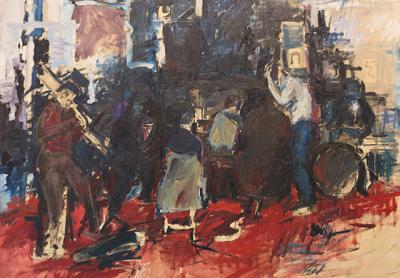A 'Season Opener' Out of the Past

Eric Firestone made a name for himself on the South Fork art scene several years ago with splashy one-off shows that attracted attention and curiosity for their flamboyant and sometimes controversial content. The shows were fun and witty, and had more complexity than a surface view might have suggested.
In his first show of the 2017 high season, he takes a more thoughtful and subtle approach. The title “Season Opener” is simply declarative. No “Blam!” No “Whiz Bang!” No “Ka-Pow!” After immersing himself in the history of the South Fork artistic community and unearthing some of its long-forgotten gems, Mr. Firestone is solidifying his place on the continuum of dealers who matter here.
Names like Miriam Schapiro, Howard Kanovitz, Sydney Butchkes, and Kyle Morris, who were once central to the local art scene, mix with others such as Michael Boyd, Jorge Fick, Ted Kurahara, Tony Robbin, and Mia Fonssagrives Solow who are separated from them by either place or time.
Mr. Firestone’s commitment to Schapiro (whose varied phases of her career were early incarnations of feminist and digital art) has dovetailed with the art world’s recognition of her pre-eminence in her generation, which began after her death in 2015.
He has chosen some unusual paintings to exhibit. “The Law,” from 1961, is a hybrid: Geometric abstraction interspersed with snippets of feigned painterly realism, areas that hint at traditional compositional norms without actually conveying a subject. The whole of the exercise is concentrated in the middle third of the canvas, as if this axial plane had a magnetic force field attracting all of the compositional forms. A circle in the middle of this column creates a central void, a white hole of negative space. A precursor to a series she called her “Shrine” paintings, this work is neither quite that, nor in the realm of the Abstract Expressionist paintings of the previous years.
“Lady Gengi’s Maze” is from 1972, when Schapiro was well into “Femage,” her use of collage to explore traditional signifiers of femininity. In this piece, she places the digitally derived hard-edge abstraction from her earlier work as a border in the lower third of the painting, and a jumble of three facsimiles of collaged works in the upper third, tumbling down from above. With a vertical plane of gray and black, and gray stairs in the background, this is one odd painting.
Yet, in their own ways, both these works are captivating. Typically, the art market seeks out and rewards an artist’s most definitive works. The unique and the experimental are ignored, or relegated to the bargain bin. What makes Mr. Firestone such an arresting seller of art is that he is as engaged with the outlier as he is with the epitome, much in the way a scholar would be. He trusts his eye to know when something is worthy of attention.
He works the same charms with Mr. Kanovitz’s paintings, blending his pioneering Photorealism works with a 1956 semi-abstraction. “Four A.M. E.S.T.” captures the manic energy of jazz musicians hitting their groove. With a minimal amount of definition, the artist creates a cast of players, but more significantly, a mood, a beat, a lively syncopation, which he lays down in short, patchy brushstrokes around them.
The two Photorealism paintings are from 1971. One is from a series that resembles photographs of doorways tacked to a wall. In this tour de force, the shadows cast by the far edges of the photo’s mat, the thumbtack, and the composition itself are all illusory. “Still Life on 18th Street” is more straightforward — realistic, but without a tromp l’ oeil intent. Instead, the painting’s diptych format presents a table on the left with an old lamp and a quadrant of a Crosby, Stills, and Nash album cover. On the left side, an entry hall is painted mostly in gray tones. The glass panes in the door frame a blue sky and clouds.
Mr. Firestone’s astute choices form a thematic suite. The allusion to music highlights Kanovitz’s friendship and allied artistic vision with Larry Rivers, with whom he played trombone in a group called the Upper Bohemia Six. Presumably, the dark figure blowing sax in “Four A.M.” is Rivers, with Kanovitz in the left foreground.
Sidney Butchkes, who died in 2015, showed regularly on the South Fork, particularly during the years of Elaine Benson’s eponymous Bridgehampton gallery. Mr. Firestone was intrigued by the artist’s obituary, seeing a man who was so esteemed at one time falling into obscurity. The sculptural paintings from the ’60s and ’70s that are the pinnacle of his work are well represented here and look fresh and relevant next to Mr. Boyd’s and Mr. Kurahara’s works, which use the tenets of Minimalist painting to similar effect.
Like Mr. Kurahara, Ms. Solow is one of the few living artists in this show. Living and working in East Hampton, she is represented here by a group of tabletop nickel-plated bronze sculptures. Their appealing reflective glimmer and simple forms seem to refer to the qualities of East End light in a direct but not obvious way.
The other artists in the show bear further exploration, but with space and time constraints, we can be grateful that Mr. Firestone will be providing us regular opportunities to see their work. This show is open through Sunday.
